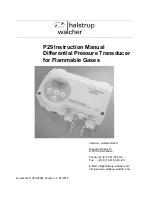
Page 4
Chapter 2 Handling Cautions
This chapter consists of cautions for transmitter handling, storage,
installation, insulation and explosion structure, etc.
Step
1
2
3
4
5
6
7
8
9
10
11
Job
Unpacking
Model and
Specifications
Storage
Calibration
Installation
Locations
Mechanical
Considerations
Electrical
Considerations
Mounting and
Installation
Calibration on Spot
Pressure
Operation
Job Details
-
Unpack transmitter packing
-
Make sure the transmitter nameplate matches the model number
on the P.O.
-
In a dry, non-vibration and non-impact area
-
Ambient temperature around 77°F (25°C) and 65% relative humidity
- Configuration of the Range, Zero/Span, Unit, Tag, Dampening
Time, Transfer Function, DA Trim and other parameters
-
Where ambient temperature are constant
-
Exposure to chemical corrosion, etc.
-
Where shock and vibration are minimal
-
Where the area classification does not exceed the explosion-proof
rating
-
Where maintenance is easy
-
Where the transmitter can be handled easily
-
Be cautious of process connections leaking
-
24 VDC
(Power Supply is 11.9 Vdc – 45 Vdc)
-
For HART
®
communication, resistance on transmitter terminal loop
should be between 250 – 550 Ohms
-
When mounting the transmitter, an appropriate bracket should be used
-
The transmitter should be mounted securely to prevent swing
-
Sensor Zero Trim should be done ten seconds after differential
pressure stabilizes
-
Make sure that PV value is zero and current is 4 mA
-
Do not apply a regulated differential pressure and line pressure
-
Close the equalizing valve on the 3 valve manifold and then open
the valve on high and low side slowly and simultaneously
- Make sure the transmitter operates properly
Instrument
- HHT
- Pressure Source
- Galvanometer
(Engineering)
(Engineering)
(Engineering)
(Mounting and Installation)
HHT or
Zero/Span button
(Applying pressure)
Eye or HHT
P-3100:TEMPLATE 3/1/10 11:27 AM Page 5






































